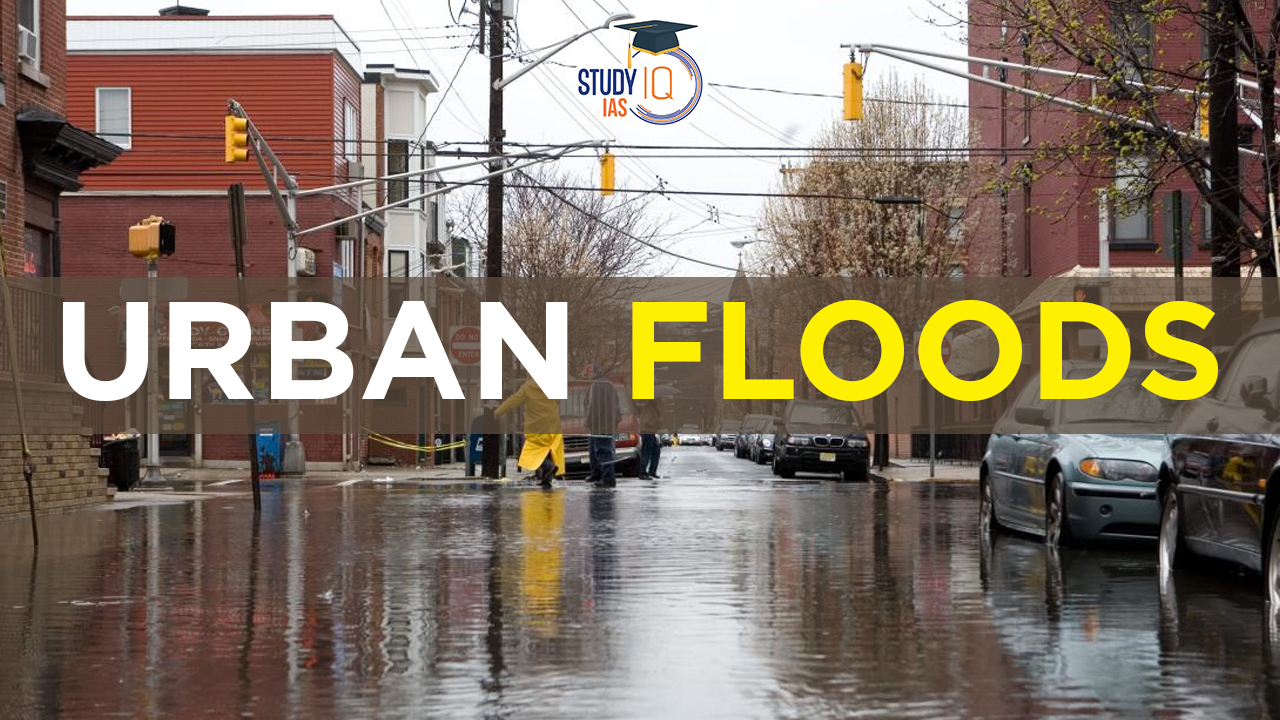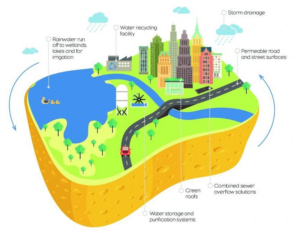Table of Contents
Context: Cyclone Michaung pummelled Chennai with torrential rains for 16 hours, causing widespread disruption and highlighting the city’s vulnerability to such disasters.
What Is Urban Flooding?
- Urban flooding is the inundation of land or property in a built environment, particularly in densely populated areas, caused by rainfall overwhelming the capacity of drainage systems.
- Unlike rural flooding, which is often caused by overflowing rivers, urban flooding is primarily driven by the unique characteristics of cities.
We’re now on WhatsApp. Click to Join
Causes Of Urban Flooding
Natural Factors
- Higher Rainfall: Increased monsoon intensity and unpredictable rainfall patterns, as per the Indian Meteorological Department (IMD), contribute significantly to urban flooding. Heavy downpours overwhelm drainage systems and natural landscapes, leading to inundation.
- Storm Surges: Coastal cities face an additional threat in the form of storm surges, which can be devastating.
- For e.g. Cyclone Amphan in 2020 serves as a stark reminder, with its devastating floods in Kolkata that claimed 98 lives and caused billions of dollars in damage.
- Climate Change: The changing climate exacerbates the risk of floods through extreme weather events.
- Increased frequency of short-duration heavy rainfall leads to higher water runoff, further intensifying flooding potential.
Check here: Cyclone Michaung
Human-Made Factors
Encroachment on Drainage Channels: Many cities have witnessed encroachment and illegal construction on water bodies like lakes, ponds, and rivers, and in urban green patches or mini forests, often referred to as ‘blue infrastructure’. This results in reduced water storage capacity and disrupts the natural water flow, leading to increased flooding during heavy rains.
- For e.g. In Hyderabad, from having 400 lakes and 48 flood-absorbing tanks in 1929, the city now has only 169 lakes.
Inadequate Drainage Systems: Many Indian cities rely on centuries-old drainage infrastructure, originally designed for a much smaller population.
- For e.g. The Karnataka State Action Plan on Climate Change (2013) had noted that drain infrastructure of Bengaluru is not enough to handle even moderate rainfall events. Yet, the infrastructure has not been upgraded.
Uncontrolled Water Release: Sudden and unplanned release of water from dams and lakes can cause devastating floods in urban areas.
- For e.g. The Chennai floods of 2015, triggered by the release of water from Chembarambakkam Lake.
- Uttarakhand Floods 2013 – The devastating flood event in Uttarakhand was exacerbated by the sudden release of water from dams located upstream.
- Urban Heat Island Effect: Cities experience higher temperatures due to the concentration of buildings and heat-generating activities. This “heat island effect” can lead to increased rainfall, further contributing to flooding risks.
- For e.g. Rapid urbanisation of Gurugram/Gurgaon has led to the construction of numerous high-rise buildings and paved areas, contributing to the city’s increasing vulnerability to floods.
- Unsustainable Development: Building structures in flood-prone areas or obstructing natural watercourses can disrupt the natural flow of water during heavy rainfall events. This can cause water to accumulate and lead to flooding.
- For e.g. Delhi Flood 2023- The Yamuna River reached a high level of 208.48 metres, causing flooding in Delhi’s low-lying areas along the riverbanks and affecting streets, as well as public and private infrastructure.
- Poor Governance: Lack of proper planning, inadequate drainage infrastructure, and poor waste management practices all contribute to urban flooding.
- For e.g. Patna (2019) experienced severe urban flooding due to the challenge faced by the municipal authorities during this crisis was their inability to locate the city’s drainage map.
- Poor Waste Management: Inefficient waste management practices lead to the accumulation of plastic and other debris in drainage channels, further obstructing water flow and increasing the risk of flooding.
- For e.g. Mumbai Flood, 2005- Experts said it is a result of clogged open surface drains with solid waste, including plastic, storm water drains and its channels.
- Illegal Mining Activities: Unsustainable practices like illegal mining of sand and quartzite for construction deplete riverbeds and lakes, reducing their water retention capacity and exacerbating flood risks.
- For e.g. The Jaisamand Lake in Jodhpur and the Cauvery River in Tamil Nadu.
Impacts Of Urban Flooding
Loss of life and injuries
- Flooded streets and buildings can lead to drowning, electrocution, and other injuries.
- For e.g. Chennai floods(2015) claimed over 300 lives, highlighting the potential for human casualties during extreme flooding events.
Economic disruption
- Flooded streets, homes, and businesses can suffer structural damage and require costly repairs.
- Businesses may be forced to close due to flooding, leading to lost revenue and unemployment.
- Disruptions to transportation and communication networks can hinder economic activity and productivity.
- For e.g. Mumbai floods (2005) caused an estimated $10 billion in economic losses, highlighting the significant financial impact of urban flooding.
Health risks
- Contaminated flood water can spread waterborne diseases like cholera, typhoid, and leptospirosis.
- Standing water can create breeding grounds for mosquitoes, increasing the risk of malaria and dengue fever.
- Psychological impacts like stress, anxiety, and depression can be experienced by individuals and communities affected by floods.
Environmental damage
- Floodwaters can carry pollutants and debris into rivers and waterways, harming aquatic life and ecosystems.
- Erosion and sedimentation can damage soil quality and agricultural land.
- Floods can also contribute to the spread of invasive species and disrupt natural habitats.
- For e.g. Kerala floods (2018) caused widespread damage to agricultural land and disrupted the local fishing industry, showcasing the environmental repercussions of urban flooding.
Way Forward
- Nature-Based Solutions (NBS): Cities are increasingly looking towards NBS, which involve utilising natural processes and ecosystems to mitigate flooding.
- For e.g. In Mumbai, initiatives like The City Fix Lab and the Climate-Proof Cities movement are focusing on reviving lakes and enhancing urban greenery.
- These efforts are cost-effective, environmentally friendly, and involve local communities, making them sustainable long-term solutions for urban flood mitigation.
- Integrated Blue-Green-Grey Infrastructure: This approach combines natural (blue-green) infrastructure with traditional (grey) water infrastructure.
- This method uses natural systems, such as parks and wetlands, to absorb stormwater runoff, retain stormwater, and mitigate impacts of coastal erosion.
- For e.g. Globally, cities like Portland, Seattle, and New York have implemented such integrated solutions at the street and neighbourhood scale, transforming hard streets into porous, green landscapes with permeable pavements and rain gardens.
- Urban Green Spaces: Transforming open spaces like city parks, playgrounds, and post-industrial zones into water-prudent landscapes has been effective in cities like Paris, Singapore, and Rotterdam.
- These spaces not only manage floodwater but also enhance urban biodiversity and provide recreational areas for residents.
- Sponge Cities Concept: This concept focuses on making cities more absorbent to water, similar to a sponge.
- For e.g. China’s Sponge City Initiative aims for cities to absorb and reuse a significant percentage of rainwater.
- National Policies and Programs: Support from national policies is crucial for widespread implementation of flood-proofing strategies.
- For e.g. In Singapore and China, national green policies and programs have been instrumental in supporting the financing and implementation of innovative hybrid solutions for urban flood management.
| What Is Sponge City Concept? |
| A Sponge City is designed to function like a natural sponge, effectively absorbing and filtering rainwater. This design allows the water to seep through the ground and replenish aquifers, which in turn supports the city’s water supply needs.
Key features of Sponge City:
|



 India to Host First Global Conference on...
India to Host First Global Conference on...
 How Terror Networks Abuse Digital Tools
How Terror Networks Abuse Digital Tools
 United Nations Population Award 2025: Va...
United Nations Population Award 2025: Va...





















